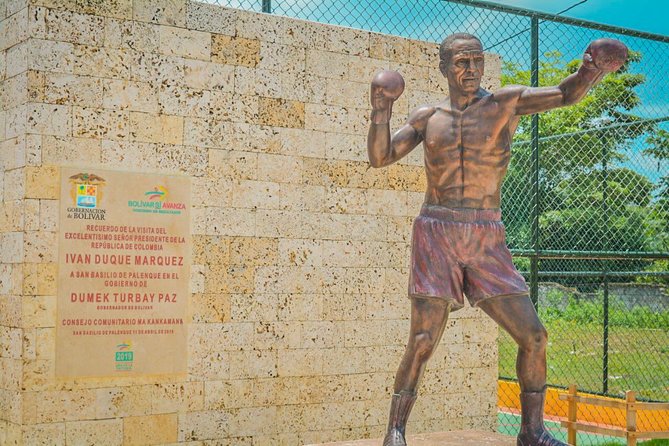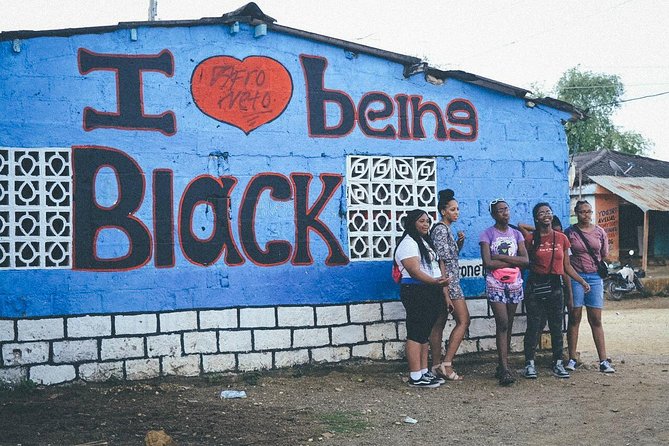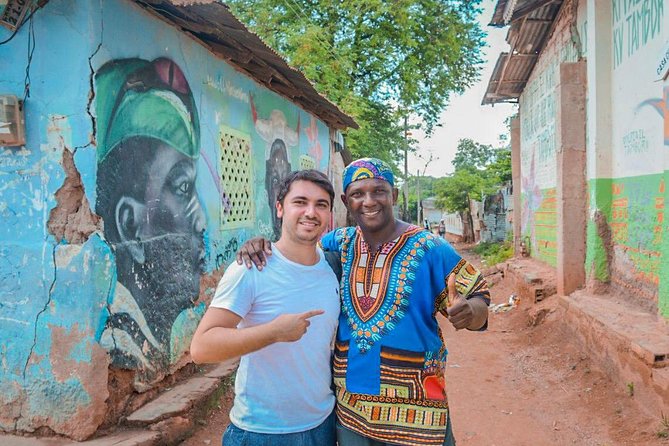Palenque de San Basilio is a remarkable community southeast of Cartagena, Colombia. Founded centuries ago by runaway slaves, it’s the only surviving palenque and a testament to the resilience of its Afro-Colombian residents. The town’s vibrant culture, rooted in its African heritage, is evident in its unique language, music, and traditions. While visitors can enjoy this rich heritage, the community’s focus on preservation and self-reliance ensures its legacy continues. There’s much to uncover about this extraordinary place and the people who call it home.
Good To Know

- Palenque de San Basilio is a historic community founded in the 17th century by runaway slaves, located southeast of Cartagena, Colombia.
- The Palenquera language, a unique Creole blending Spanish and Bantu grammar, is essential for preserving the community’s cultural identity and social cohesion.
- Cultural practices in Palenque, including music, dance, and oral storytelling, reinforce the historical significance of the community within Colombian culture.
- Tourism to Palenque supports local economic development and cultural preservation efforts, providing employment opportunities and promoting sustainable community-based initiatives.
- As the only surviving palenque, Palenque de San Basilio serves as a model for the preservation of Afro-Colombian heritage and a source of pride for its approximately 3,500 inhabitants.
Overview of Palenque De San Basilio
What’s Palenque de San Basilio? It’s a cultural space founded in the 17th century by runaway slaves, located southeast of Cartagena, Colombia.
It’s the only surviving palenque, with around 3,500 inhabitants. The community preserves social, medical, and religious practices, as well as musical and oral traditions rooted in African heritage.
Notable musical expressions include "sitting Bullernege," "Son palenquero," and "Son de negro," integral to collective celebrations.
The Palenquera language is a unique Creole, blending a Spanish lexical base with Bantu grammar. This language is vital for social cohesion and reflects the African roots of the culture, encompassing music, dance, and oral storytelling.
You can also read our reviews of more tours and experiences in Cartagena.
Cultural Significance and Language

The Palenquera language is a vital component of the community’s cultural identity. This unique Creole language blends a Spanish lexical base with Bantu grammatical features, reflecting the African roots of the Palenque de San Basilio culture.
The language is essential for social cohesion among community members, serving as a means of communication and preserving their heritage.
Beyond language, the community’s cultural practices encompass various aspects of life, including music, dance, and oral storytelling. These traditions reinforce the historical significance of Palenque de San Basilio, making it a vibrant and culturally rich enclave within the larger Colombian landscape.
Tour Experience

Tours to Palenque de San Basilio offer visitors a chance to enjoy the community’s rich cultural heritage.
Typically, the tours last around 2 hours and include lunch and beverages. Pickup points are available in areas like Bocagrande, Laguito, and Getsemani. The experience is designed for travelers with moderate physical fitness, and confirmation is received upon booking.
Visitors can take advantage of free cancellation up to 24 hours before the tour. While the overall tour rating is 4.0 based on 30 reviews, some guests have expressed concerns about transportation comfort, bathroom facilities, and guide communication skills.
The educational aspects of the tour are widely appreciated by visitors.
Visitor Reviews and Feedback
A large number of visitors have provided mixed reviews for the Palenque de San Basilio tour experience, with an overall rating of 4.0 based on 30 reviews.
Positive feedback highlights knowledgeable and friendly guides, enriching cultural experiences, and good food.
However, some visitors expressed disappointment regarding transportation comfort, bathroom facilities, and guide communication skills.
Specific comments include issues with cleanliness and the need for better amenities.
Despite the mixed feedback, many visitors appreciate the educational aspects of the tour and express a desire to return and further explore the culture of Palenque.
Recommendations for Visitors
Small bills in Colombian pesos are advisable for tips and restroom usage when visiting Palenque de San Basilio.
Plus, visitors should consider the following recommendations:
- Wear sun protection like sunscreen and hats to guard against the heat.
- Bring comfortable walking shoes as the tour involves moderate physical activity.
- Familiarize yourself with the community’s cultural practices and history to fully appreciate the experience.
- Be respectful of the local customs and traditions to ensure a meaningful and memorable visit.
Following these tips will help visitors make the most of their exploration of the unique and enriching culture of Palenque de San Basilio.
History and Founding

Palenque de San Basilio traces its origins back to the seventeenth century when it was established by Africans who’d escaped slavery.
These runaway slaves, known as Cimarrones, formed their own autonomous community in the hills near Cartagena.
Over time, Palenque de San Basilio became a refuge for many who sought to preserve their African heritage and traditions.
Today, it remains the only surviving palenque, with a population of around 3,500 people.
The community’s cultural practices, including music, dance, and oral storytelling, continue to reflect its deep roots in African culture, making it a unique and significant part of Colombia’s history.
Cultural Preservation Efforts
The community of Palenque de San Basilio has undertaken significant efforts to preserve its rich cultural heritage. As the only surviving palenque in Colombia, the town is committed to safeguarding its social, medical, and religious practices, as well as its musical and oral traditions rooted in African ancestry.
This preservation work includes:
-
Promoting the Palenquera language, a unique Creole blending Spanish and Bantu elements, which is vital for community cohesion.
-
Celebrating collective events that showcase traditional music, such as "sitting Bullernege," "Son palenquero," and "Son de negro."
-
Passing down oral storytelling and other cultural practices to the younger generation.
-
Welcoming visitors to experience and learn about the community’s rich heritage.
Impact on Community Development
Alongside its cultural preservation efforts, the community of Palenque de San Basilio has leveraged its unique heritage to drive local development.
Tourism has become a vital part of the economy, with visitors eager to experience the community’s vibrant traditions. This has created employment opportunities, boosting incomes and improving standards of living.
Plus, the community has established cooperative initiatives, such as artisanal workshops, that empower residents and foster self-reliance.
By embracing their cultural identity, the people of Palenque have found ways to uplift their community, demonstrating the transformative power of preserving one’s roots.
This holistic approach has positioned Palenque as a model for sustainable development rooted in cultural heritage.
Frequently Asked Questions
How Are the Traditional Crafts of Palenque De San Basilio Made?
Traditional crafts of Palenque de San Basilio are handmade using techniques passed down for generations. Skilled artisans weave intricate baskets, fashion pottery, and create vibrant textiles that reflect the community’s rich African heritage and cultural identity.
What Is the Significance of the Traditional Architecture in the Community?
The traditional architecture of Palenque de San Basilio reflects its history as a refuge for escaped slaves. The simple, compact structures and communal spaces embody the resilience and collective spirit that have sustained the community over centuries.
Are There Any Educational Programs Available for Visitors to Participate In?
Visitors can participate in educational programs that showcase the community’s traditional practices and heritage. These programs provide hands-on experiences, allowing travelers to enjoy the cultural richness of Palenque de San Basilio.
How Do the Residents of Palenque Earn Their Livelihood?
The residents of Palenque de San Basilio earn their livelihood through a mix of traditional crafts, small-scale agriculture, and participation in the local tourism industry. They maintain their cultural heritage while adapting to modern economic realities.
What Are the Common Health Practices and Traditional Medicines Used in the Community?
The community uses traditional herbal medicines and remedies passed down through generations to treat common ailments. Traditional healers provide healthcare services, drawing on African-influenced practices that are integral to the community’s cultural identity.
The Sum Up
Palenque de San Basilio proudly preserves its African heritage, offering visitors a unique cultural experience. The community’s vibrant traditions, language, and music captivate travelers, while tourism bolsters the local economy and fosters self-reliance. As the only surviving palenque, this resilient settlement showcases the enduring spirit of its founders – the runaway slaves who established it centuries ago.
More Tour Reviews in Cartagena
Not for you? Here's more nearby things to do in Cartagena we have reviewed
- Tour of Cholón Island Rosario Islands
- Cartagena in Times of War
- Cartagena: Roman Forum Entry Ticket
- Cartagena : Roman Theatre Museum Entry Ticket
- Cartagena: Panoramic Lift & Conception Castle Ticket
- 25 Best Tours In Cartagena
- 21 Best Guided Tours In Cartagena
- 3 Best National Park Tours In Cartagena
- 12 Best Shore Excursions In Cartagena
- 16 Best Shopping Tours In Cartagena
- 25 Best Drinking Tours In Cartagena
- Ecoruta Volcano of Totumo and Experience in the Mangroves
